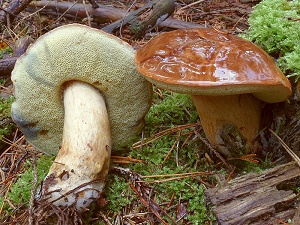| Boletus badius (Fr.:Fr.) Fr. |
|
|
|
|
|
|
The cap is usually reddish brown to chestnut brown, ranging from ochre to almost black (young specimens), firm, fleshy, of hemispherical then convex shape, often bumpy, then flattened. The cap surface is downy and dry, becoming smooth and shiny with age, slightly sticky when damp and not peelable. The stem is full and rather fibrous, quite variable (slender or on the contrary short and thick, often crooked). It is more or less equal or slightly spindle-shaped, smooth or covered with fine, longitudinal, brown and dense fibrils (like wood veins), but without network. Its colour is pale yellow-brown, paler than the cap, except at the base. The flesh is whitish to locally pale yellow, faintly red-brown under the surface, firm for a long time then soft when ageing. It turns blue but not intensely when cut and exposed to air depending on the humidity level, in particular above the tubes and in the stem base (reaction with oxygen caused by the presence of the boletol compound); its taste is pleasant; the odour is weak, mushroomy but pleasant and slightly fruity; The tubes are adnate, round and sometimes shorter near the stem, rather long (6-15mm), cream to pale yellow then olivaceous yellow. The pores are very small, white and angular in young specimens, then larger, olive yellow, turning slightly dark blue when pressed, except in dry weather. The spore print is pale greenish brown. It grows in coniferous or broad-leaved woods, more often at sea level than in the mountains. It privileges coniferous woods, where it comes in large troops, but it can also be found with deciduous trees, with more solitary individuals. It can be found frequently close to dead trees, on sandy and siliceous ground, on a rather acid soil, with pine, spruce, chestnut, beech, oak. The fruiting period takes place from June to December.
Distinctive features : bay-brown cap with a sticky surface when moist, but not easily peelable; pores getting slightly blue when pressed; no network on stem; Boletus badius is frequent and present everywhere in the forest of Rambouillet, and is very frequent, more generally speaking . | ||
|
page updated on 14/01/18

